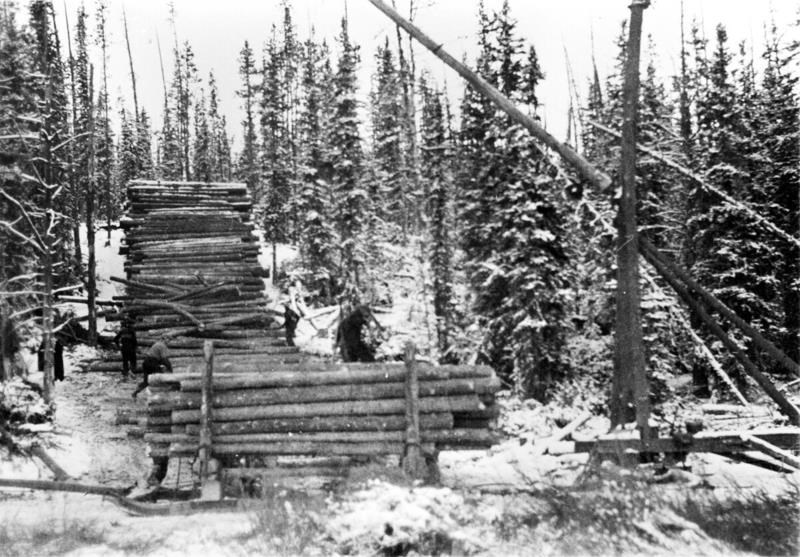MD OF BIGHORN – The MD of Bighorn is taking another swing at a forestry history project to help conserve the region’s logging and forest fire protection heritage.
Council endorsed the Heritage Resources Committee’s recommendation to hire Folklore Research to complete the project with a significant amount of research already done but left incomplete by another contractor hired by the MD in 2019.
The Cochrane-based consultant will develop a package of written and oral forestry history, including a historical document posted on the MD of Bighorn’s website, interviews with MD residents with firsthand knowledge and a video on the themes of logging and forest fire protection in the area.
“There’s a lot of work that involves visiting sites, working with the interviewees and providing the primary information – the research information that we need to complete this document,” said Wayne Shanks, Bighorn’s interim director of planning and development services.
Prior to the COVID-19 pandemic, the MD hired Fireweed Consulting for the forestry project, meant to build on the MD’s oral history initiative – a collection of first-person interviews that began in 2011, with persons of interest in the region.
Due to the pandemic, however, Fireweed was unable to conduct expected interviews and failed to produce a video. The two documents it delivered were deemed insufficient by heritage committee members of the time, who felt “the narrative lacked cohesion, contained inaccuracies and needed to include more relevant information and photographs,” states a staff report.
The MD issued a new request for proposal (RFP) in October and received three proposals with an approved $15,000 in its 2023 budget.
Key objectives of Folklore’s proposal include examining the history of logging and fire prevention in Bighorn, collecting data on significant industry moments, relating forestry practices to the present and developing a narrative centred around key figures in the MD.
The Calgary-based Eau Claire and Bow River Lumber Company – the biggest logging operation in Alberta before 1930 – did much of its logging in the Ghost River area, driving logs down Waiporous Creek and the Ghost and Bow rivers, in addition to Kananaskis River.
In the Ghost Watershed Alliance Society’s 2018 State of the Watershed Report, it’s noted three families owned and operated small sawmills after 1930 in the Jamieson Road area.
“All these small sawmills harvested trees by hand, with horses and small tractors,” states the report.
In his oral history video, interviewed by former MD Coun. Erik Butters, who now chairs the Heritage Resources Committee, MD resident Paul Gibson talks about his family’s sawmill operations off Jamieson Road in the 1950s.
Gloria and Dalton Gibson purchased 800 acres for logging operations at the end of the road where Gibson’s parents built their first house and started a lumber mill, known as the Little Giant Sawmill.
MD resident Bob Allen also shared stories with the MD of his family moving to Jamieson Road around the same time, where the neighbourhood he lived was built around timber operations.
“For a few years, I think two to three years, we had a family-run sawmill where my dad would log during the week,” said Allen. “My brother and I, when we come home from school, we’d go out and skid logs and help out. And then on the weekends, we would mill.”
Today, logging is still a prominent industry in the MD, with much of its 276,800 hectares comprised of forested Crown land.
In 1921, two years after what became known as “The Great Fire” that burned 2.8 million hectares across southeastern Alberta and Saskatchewan, the first fire control plan was developed for Alberta’s forests and the first fire lookout was constructed.
In 1928, Black Rock Mountain Fire Lookout was built by the Alberta Forest Service. It was the second highest fire lookout of its design at the time at 2,463 metres, located on the eastern fringe of the Canadian Rockies in what would become known as the MD of Bighorn.
The prominent, exposed peak the lookout still sits atop on Black Rock Mountain offered panoramic views for smoke and fire detection, but was often battered by inhospitable weather and hindered by cloud coverage.
Construction materials for the cupola-style cabin – designed to be open on all sides and for observation only – were carried to the summit of the mountain by pack horses. The lookout was set on concrete blocks, tethered to the mountain using steel cables and instead of being equipped with radio for communication like most, it was connected by telephone lines to the nearby Aura Ranger Station, which is now the site of the Rocky Mountain National Army Cadet Summer Training Centre.
In 1950, the lookout was abandoned when a section of the trail leading to it collapsed. A more accessible observation site – the Mockingbird Hill Fire Lookout was built east of Black Rock Mountain.
In 2016, the Black Rock fire lookout was included on a list of historically significant sites in the MD submitted by Bighorn council to the Alberta government for Provincial Historic Resource status. Despite its exposure, the lookout still stands and has also become a popular hiking destination. It was, however, declined by the province for the designation which comes with legal protections to recognize and protect historic places.
Cataloguing the MD’s forestry history is recognized as an important preservation effort in its Heritage Management Plan. The Black Rock fire lookout was added to the MD’s heritage inventory in 2011.
The forestry history project is expected to have a final report and video to MD council in summer 2024.
The Local Journalism Initiative is funded by the Government of Canada. The position covers Îyârhe (Stoney) Nakoda First Nation and Kananaskis Country.




